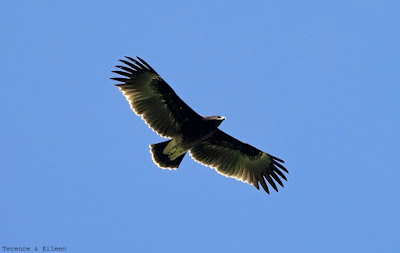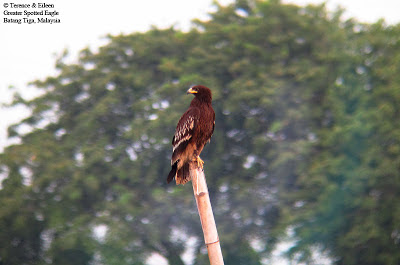Pied Harrier Circus melanoleucus (Pennant) 1769
Pied Harrier Circus melanoleucus (Pennant) 1769
Other Name: Nil
Migrant
Status and distribution
Found throughout Peninsula Malaysia south to Johore. Recorded more on west coast rather then East Coast. Some state remain rare such as Kelantan. Further effort to detect such species in are mention are required
Uncommon no breeding visitor in Borneo.
Description
Adult male
White underbody contrasting with black head and breast. Upperbody median covert and breast are black. Other remaining part of the wing are grey with white leading edge. Black head with contrasting yellow eye are distintive.
Female
Very pale underwing with narrow dark bar on flight feather. Underpart pale – white based with rufous – brown streaking on the underpart. Streaking are distinctive but do not cover thigh. See confusion species for more description
Juvenile
Distinctive white supercilium and patch below the eye and have dark eye. This is contrast to the overall head which is brown together with the upperpart of body. Underpart show rufous brown in colour. This however can be seen chocolate in colour especially during transition period.
Confusion Species
Black Shouldered Kite
Low flying male may be easily overlooked to this species. Pied Harrier can be easily separated from Black Shouldered Kite from solid black head compare to pale white head of Black Shouldered Kite.
Eastern Marsh Harrier
The difference can be observed start with the head. In Pied Harrier, the facial disk is more distinctive and the throat is streak or mark compare to Eastern Marsh Harrier. In Pied Harrier the area surrounding the eye shall be pale to white at time the feature is distinctive enough to create a boarder around it. In Eastern Marsh Harrier this feature is brownish all over as in this picture.
Moving downwards to the underbody, Eastern Marsh Harrier will show narrow streak. The side of the body streaking restricted only to the lower breast and not extended lower. In Pied Harrier, the female streak on the side of body shall extended all the way down as in the picture above. The marking of the steak are also thicker and also all the way down to lower body and more elongated. The only part which is absent of streaking is the thigh. This feature however requires a careful observation as when the feature ruffle up, the thigh may at time appear mark but was actually the feather of the side of body.
Moving lower let have a look on the leg. The leg colour is solid yellow distinctive to very young pied(only some) and also Eastern Marsh Harrier. Majority of adult pied will show some orangish tinge in the yellow leg.
Moving on to the wing. Both show streaking on the underwing covert at some stage of moult and age. The Eastern Marsh Harrier show narrower and the streaking is random and not well arrange. In Pied Harrier, the streaking are more rufous and more important is that they are more well arrange and appear to be in one line. This feature more crucial if you see the first line the covert meeting the flight feather which will always arrange in a line bordering the two part of the bird. This feature is completely differ with Eastern Marsh Harrier. Eastern Marsh Harrier can be also completely absent of any marking on the underwing covert. See photo below
Another jizz we can used however for less experience lets forget about this which is the bill. The bill appear to look solid large and make the bird appear strong. This feature mainly for the Marsh Harrier and not the Pied Harrier.
Some male Eastern Marsh Harrier show solid black head as well which very resemble to Pied Harrier however such individual usually show streaking after the solid black head marking. In flight the upper part is distinctive feature to note in separation of the two species.
Hen Harrier / Pallid Harrier
Pied Harrier female can be confuse to any of the female and subadult female harrier of the above two species. Wing formula maybe a key to distinguish the s Pied Harrier especially with Pallid Harrier. In regards to Female Hen Harrier care noted on the facial feature will be required. In Hen Harrier female will show broader dark terminal band where equal length in Pied harrier. Facial feature are also distinctive different. In many cases underwing covert of the female Hen Harrier are less heavily streak on buff based colour compare to white of the Pied Harrier.
Considering the noted hybrid of the above two species more care needed if one trying to separate pied harrier to hen/pallid harrier.
Geographical Variation
Monotypic
Behaviour
Roost together with the eastern Marsh Harrier with the noted below ration
EMH:Pied approximately 7-10:1 depending on site and year observed.
In regards to male adult pied harrier to other pied harrier age and sex are 13:1 with the deviation of +/- 2.
The have been consistently observed in 3 roosting site for the period of 3 years.
During migration arrive as early as October. Movement peak at end of October and November with roosting observation peak at December and January. After of which bird number varies as movement began slowly north bound. Extreme time at end of march and April.
It was also observed feeding on insect. While hunting are very similar to the other harrier, it was also noted that some of the pied harrier tend to hover before landing on the prey. Pied harrier feed on the ground once prey was catch. Rarely seen carrying prey to other perch.
Habitat
Very similar to Eastern Marsh Harrier open wetland, marshland and also paddyfield. In most area this were species were detected in paddyfield.
Breeding
Non breeding.
















Comments
Post a Comment